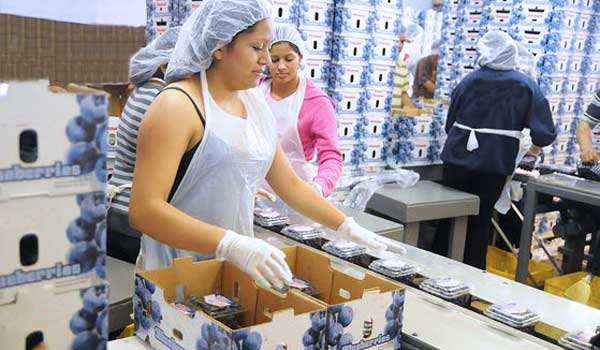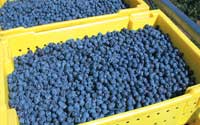
Market Report:
Prices Low in Summer Fruit; In Frozen, Lots of B, But A Grade in Short Supply
Fresh market blueberry prices suffered this summer when the major U.S. summer production areas all hit the market at the same time.
“Oregon, Washington, B.C., Michigan and New Jersey all came on together,” said Cort Brazelton of Fall Creek Nursery. “It caused capacity issues, pricing issues and planting issues. It was a problem and a lot of growers did not make the money that they were hoping for. It was a very hard year for them.”
Crop volume, meanwhile, was up in Oregon and Washington, Brazelton said, and decent in Michigan, New Jersey and British Columbia.
 The result was low prices from the end of June through the first half of August. The result was low prices from the end of June through the first half of August.
Growers also this summer faced challenges with labor supplies, labor costs and regulatory officials.
“There were lots of challenges,” Brazelton said.
On the plus side, consumption continues to increase.
“We had incredible movement at the retail and consumer end,” Brazelton said. “More people are eating blueberries than ever. Every year, blueberry consumption has increased, and it is continuing to increase.
“We’ve got great consumption growth as our product quality improves with new varieties, better packing systems and better post-harvest management,” he said.
Quality in the 2013 crop was generally good, Brazelton said, despite some issues in isolated areas. Jeff Malensky of Oregon Berry Packing also reported some grade declines due to spotted wing drosophila in the later season varieties.
Frozen supplies, meanwhile, are up, but some speculate there is a shortage of Grade A berries.
“Inventories are up,” Brazelton said. “The challenge is what are the grades and what are the demands of the different markets.
“There is some concern right now that there may not be enough A Grade for certain uses,” Brazelton said.
“My orders are really tight,” Malensky said of his Grade A frozen orders. “I can’t take any new business and just trying to fulfill the orders I have is a challenge.”
USDA inventory numbers were at historical highs in the July 31 report, with 166 million pounds in inventory. That compares to 148 million pounds at that time a year ago and 76 million pounds at that date in 2011.
“But,” Malensky said, “what those numbers don’t tell me is how much of that is Grade A.”
Malensky said he couldn’t sell his Grade B berries this winter, but once he re-ran them and they made Grade A, the berries moved quickly.
“When I made Grade A and started making calls, I found that I couldn’t make enough Grade A. It wasn’t within a week that I had more sales than I had volume, and I kept getting calls,” he said.
“I think there is a lot of low quality fruit,” he said. “How much is represented by the total number (of pounds in inventory), I don’t know. But I think it is more than it should be.”
As for frozen prices, Malensky said they are fluctuating greatly depending on grade. And, he said, for the second year in a row, major industrial buyers are late in setting a frozen price. “Usually we would have a grower price set in August,” he said. “Last year was the first year that we couldn’t go to our growers and say, ‘This is what the grower price will be,’ because that grower price is prefaced on the sale price. Well, when you don’t know what the sale price is in the marketplace, then you can’t set a grower price.
“That is similar to this year. We are trying to figure out what that grower price is, because there isn’t a set price,” he said.
“On the fresh end there is a short supply and the prices keep going up,” he said.
Even so, he said, fresh prices are lower this year than last year at this time, which has helped increase movement.
“To the buyer it is a better price and more movement happens when we get to these pricing levels,” Malensky said.
Looking to the future, Brazelton said breeders are releasing several new late-season varieties that show promise and should have a good fit in the marketplace.
“There are huge opportunities now in the late season with quality fruit,” Brazelton said. “In an eight week period, North America goes from moving 30 to 40 million pounds a week to moving 3 to 5 million. If that isn’t an opportunity, I don’t know what is.”
The trick will be for growers to determine which varieties work best for their operation.
“The challenge for growers will be discerning what is good, what is not,” he said. “What is the best for me?
“The opportunity is there to look for good information, to trial them, to go see them, if possible, and to evaluate for themselves if they think they deliver value. “There is always a risk with new varieties, so you have to get as much information as you can to make good decisions to evaluate that risk,” he said.
Brazelton also sees good market opportunities in export markets.
“Demand is growing in Europe, throughout Asia and even in South America,” he said. “The issue oftentimes is just getting the product there. It’s distribution or market access or it’s high tariffs.”
|
|
|
